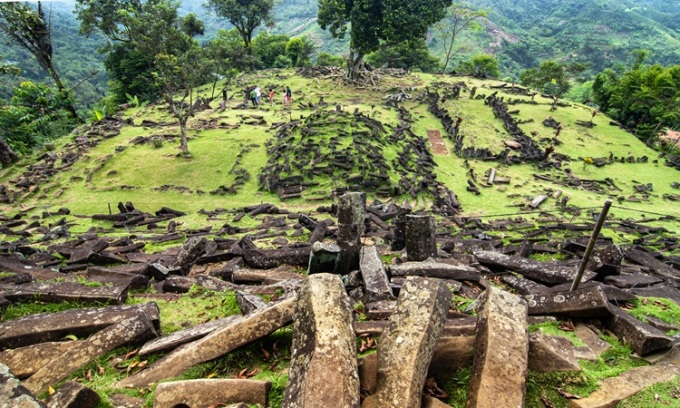Indonesia The Gunung Padang Pyramid was built in four stages 25,000 years ago and was previously mistaken for a hill.

Megalithic rocks at the top of Gunung Padang. Photo: Wikipedia
New research has revealed that the oldest man-made cone-shaped monument in Indonesia may have been built 25,000 years ago. The site, called Gunung Padang, was previously mistaken for a natural hill. Field work has shown that the entire structure was built by human hands over several millennia, IFL Science reported on November 3.
Located in the Cianjur district of West Java, Gunung Padang is a megalithic complex perched on a mountainside. It wasn’t until 2018 that archaeologists first suggested that the entire mound might be man-made and that Gunung Padang contained more than just the obvious stone structures on its surface. This conclusion came from an interdisciplinary team of researchers who spent three years surveying the site between 2011 and 2014.
Although many experts were initially skeptical, the team has now published a detailed description of the investigation in the journal Archaeological Prospection, providing solid evidence to support the hypothesis that Gunung Padang is the world's oldest pyramid. Carbon dating of organic soils taken from the structure reflects multiple construction phases dating back thousands of years BC. The first phase began in the Paleolithic period.
Using a variety of techniques including electrically-generated resonant waves (ERT), ground-penetrating radar (GPR), and seismic waves (ST), the team was able to develop a complete picture of the mountain’s internal features and the age of its construction. Cores drilled at seven different locations revealed that the pyramid was built in four distinct phases, spanning thousands of years.
20–30 m high, construction began with Cluster 4. Buried deep within the mountain, the first phase likely began as a natural lava hill, meticulously carved into its present form 25,000–14,000 years ago. Cluster 3 consists of stone columns arranged like bricks in a building, built between 7,900–6,100 BC. Approximately a millennium later, between 6000 and 5,500 BC, a mason arrived at Gunung Padang and built Cluster 2. The last mason arrived between 2000 and 1100 BC and built Cluster 1.
The team also found evidence of “hidden niches or chambers within the structure,” which will need to be explored in detail in future field surveys. The new findings challenge the theory that complex construction techniques only developed with the advent of agriculture around 11,000 years ago, the researchers said.
An Khang (According to IFL Science )
Source link




















































![[Maritime News] More than 80% of global container shipping capacity is in the hands of MSC and major shipping alliances](https://vphoto.vietnam.vn/thumb/402x226/vietnam/resource/IMAGE/2025/7/16/6b4d586c984b4cbf8c5680352b9eaeb0)













































Comment (0)